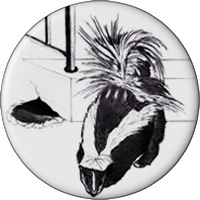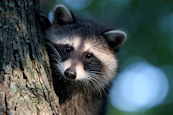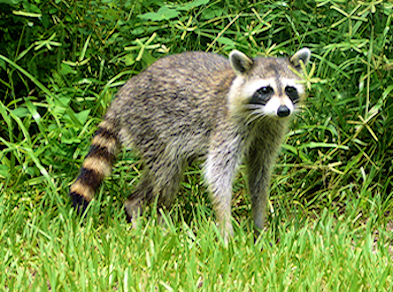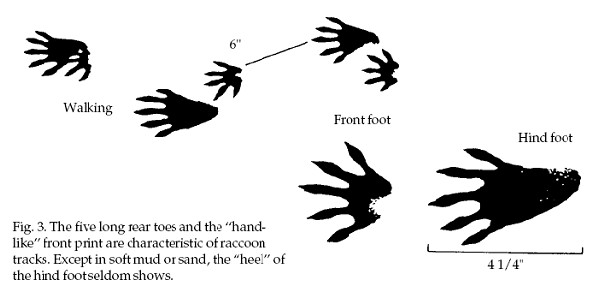RaccoonsIdentification
General Biology, Reproduction, and Behaviour Raccoons are omnivorous, eating both plant and animal foods. Plant foods include all types of fruits, berries, nuts, acorns, corn, and other types of grain. Animal foods are crayfish, clams, fish, frogs, snails, insects, turtles and their eggs, mice, rabbits, muskrats, and the eggs and young of ground-nesting birds and waterfowl. Contrary to popular myth, raccoons do not always wash their food before eating, although they frequently play with their food in water.
Raccoons are nocturnal. Adult males occupy areas of about 8 to 52 km2 (3 to 20 square miles), compared to about 3 to 16 km2 (1 to 6 square miles) for females. Adult males tend to be territorial and their ranges overlap very little. Raccoons do not truly hibernate, but they do “hole up” in dens and become inactive during severe winter weather. In the southern United States they may be inactive for only a day or two at a time, whereas in the north this period of inactivity may extend for weeks or months. In northern areas, raccoons may lose up to half their fall body weight during winter as they utilize stored body fat. Raccoon populations consist of a high proportion of young animals, with one-half to three-fourths of fall populations normally composed of animals less than 1 year in age. Raccoons may live as long as 12 years in the wild, but such animals are extremely rare. Usually less than half of the females will breed the year after their birth, whereas most adult females normally breed every year. Damage and Damage Identification
Raccoons may cause damage or nuisance problems in a variety of ways, and their distinctive tracks (Fig. 3) often provide evidence of their involvement in damage situations. Raccoons occasionally kill poultry and leave distinctive signs. The heads of adult birds are usually bitten off and left some distance from the body. The crop and breast may be torn and chewed, the entrails sometimes eaten, and bits of flesh left near water. Young poultry in pens or cages may be killed or injured by raccoons reaching through the wire and attempting to pull the birds back through the mesh. Legs or feet of the young birds may be missing. Eggs may be removed completely from nests or eaten on the spot with only the heavily cracked shell remaining. The lines of fracture will normally be along the long axis of the egg, and the nest materials are often disturbed. Raccoons can also destroy bird nests in artificial nesting structures such as bluebird and wood duck nest boxes. Raccoons can cause considerable damage to garden or truck crops, particularly sweet corn. Raccoon damage to sweet corn is characterized by many partially eaten ears with the husks pulled back. Stalks may also be broken as raccoons climb to get at the ears. Raccoons damage watermelons by digging a small hole in the melon and then raking out the contents with a front paw. Raccoons cause damage or nuisance problems around houses and outbuildings when they seek to gain entrance to attics or chimneys or when they raid garbage in search of food. In many urban or suburban areas, raccoons are learning that uncapped chimneys make very adequate substitutes for more traditional hollow trees for use as denning sites, particularly in spring. In extreme cases, raccoons may tear off shingles or facia boards in order to gain access to an attic or wall space. Raccoons also can be a considerable nuisance when they roll up freshly laid sod in search of earthworms and grubs. They may return repeatedly and roll up extensive areas of sod on successive nights. This behaviour is particularly common in mid to late summer as young raccoons are learning to forage for themselves and during periods of dry weather when other food sources may be less available. |



 The raccoon (Procyon lotor), also called “coon,” is a stocky mammal about 61 - 91 cm (2 - 3 feet) long, weighing 4.5 - 13.5 kg (10 to 30 pounds) (rarely 18 - 22.5 kg [40 - 50 pounds]). It is distinctively marked, with a prominent black “mask” over the eyes and a heavily furred, ringed tail. The animal is a grizzled salt-and-pepper gray and black above, although some individuals are strongly washed with yellow. Raccoons from the prairie areas are paler in color than those from eastern portions of the region.
The raccoon (Procyon lotor), also called “coon,” is a stocky mammal about 61 - 91 cm (2 - 3 feet) long, weighing 4.5 - 13.5 kg (10 to 30 pounds) (rarely 18 - 22.5 kg [40 - 50 pounds]). It is distinctively marked, with a prominent black “mask” over the eyes and a heavily furred, ringed tail. The animal is a grizzled salt-and-pepper gray and black above, although some individuals are strongly washed with yellow. Raccoons from the prairie areas are paler in color than those from eastern portions of the region. Raccoons breed mainly in February or March, but matings may occur from December through June, depending on latitude. The gestation period is about 63 days. Most litters are born in April or May but some late-breeding females may not give birth until June, July, or August. Only 1 litter of young is raised per year. Average litter size is 3 to 5. The young first open their eyes at about 3 weeks of age. Young raccoons are weaned sometime between 2 and 4 months of age.
Raccoons breed mainly in February or March, but matings may occur from December through June, depending on latitude. The gestation period is about 63 days. Most litters are born in April or May but some late-breeding females may not give birth until June, July, or August. Only 1 litter of young is raised per year. Average litter size is 3 to 5. The young first open their eyes at about 3 weeks of age. Young raccoons are weaned sometime between 2 and 4 months of age.